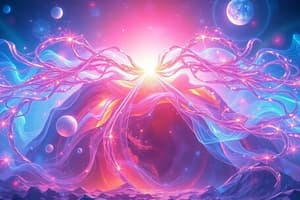Podcast
Questions and Answers
What is formed when hydrochloric acid reacts with ammonia gas?
What is formed when hydrochloric acid reacts with ammonia gas?
- Ammonium chloride gas (correct)
- Sodium chloride solution
- Calcium hydroxide
- Magnesium oxide powder
What happens when a magnesium strip ignites in the air?
What happens when a magnesium strip ignites in the air?
- White smoke is formed
- Hydrogen gas is produced
- Lime is produced
- Magnesium oxide powder is formed (correct)
What is the chemical equation for the formation of calcium hydroxide (Ca(OH)2)?
What is the chemical equation for the formation of calcium hydroxide (Ca(OH)2)?
- NH3 + HCl -> NH4Cl(s)
- NH3 + HCl -> NH4Cl(g)
- CaO + H2O -> Ca(OH)2 + Heat (correct)
- 2Mg + O2 -> 2MgO
What causes the white smoke observed during the reaction between hydrochloric acid and ammonia gas?
What causes the white smoke observed during the reaction between hydrochloric acid and ammonia gas?
What product is formed when hydrogen chloride and ammonia gas react?
What product is formed when hydrogen chloride and ammonia gas react?
Which reaction results in the generation of a large amount of heat?
Which reaction results in the generation of a large amount of heat?
Which process is being demonstrated by heating lime stone powder in an evaporating dish?
Which process is being demonstrated by heating lime stone powder in an evaporating dish?
What is the key difference between a physical change and a chemical change?
What is the key difference between a physical change and a chemical change?
What can be concluded from adding zinc dust to copper sulphate solution?
What can be concluded from adding zinc dust to copper sulphate solution?
Which of the following best describes a chemical reaction?
Which of the following best describes a chemical reaction?
When sodium carbonate solution is added to calcium chloride solution, what phenomenon is observed?
When sodium carbonate solution is added to calcium chloride solution, what phenomenon is observed?
What is the purpose of heating the evaporating dish slowly on a tripod stand during the experiment?
What is the purpose of heating the evaporating dish slowly on a tripod stand during the experiment?
What is the term for substances that take part in a chemical reaction?
What is the term for substances that take part in a chemical reaction?
What does the observation in the funnel during heating phthalic anhydride indicate?
What does the observation in the funnel during heating phthalic anhydride indicate?
Which of the following is NOT an indication of a chemical change?
Which of the following is NOT an indication of a chemical change?
In a physical change, what remains constant despite any alterations in appearance?
In a physical change, what remains constant despite any alterations in appearance?
Why is it important to record temperatures during some activities in the experiment?
Why is it important to record temperatures during some activities in the experiment?
When ice is transformed into water upon heating, what kind of change is this?
When ice is transformed into water upon heating, what kind of change is this?
Study Notes
Physical and Chemical Changes
- Physical changes occur due to changes in parameters like temperature and pressure, and are often reversible.
- The composition of matter remains the same in a physical change.
- Examples of physical changes:
- Transformation of ice into water on heating
- Transformation of water into ice on cooling
- Chemical changes occur when the composition of matter changes during a process.
- Chemical reactions involve bond breaking and formation of new bonds, resulting in new substances.
- The substances involved in a chemical reaction are called reactants, and the resulting substances are called products.
- Example of a chemical reaction:
- Combustion of coal in air to form carbon dioxide gas
Activities and Observations
Activity 1: Heating of Lime Stone Powder
- Heated lime stone powder in an evaporating dish on a high flame.
- Observed temperature change.
Activity 2: Zinc and Copper Sulphate
- Added zinc dust to copper sulphate solution.
- Observed temperature change.
Activity 3: Potassium Chromate and Barium Sulphate
- Added potassium chromate solution to barium sulphate solution.
- Observed temperature change.
Activity 4: Sodium Carbonate and Calcium Chloride
- Added sodium carbonate solution to calcium chloride solution.
- Observed temperature change.
Activity 5: Phthalic Anhydride
- Heated phthalic anhydride in an evaporating dish on a low flame.
- Observed a cotton plug in the funnel to collect the product.
Activity 6: Hydrochloric Acid and Ammonia
- Heated hydrochloric acid in a test tube.
- Held a glass rod with ammonia solution near the test tube.
- Observed white smoke, which is a solid compound formed by the reaction between ammonia and hydrogen chloride gases.
Activity 7: Magnesium and Oxygen
- Ignited a magnesium strip in air.
- Observed the formation of white powder of magnesium oxide.
Activity 8: Slaked Lime and Water
- Added slaked lime to water.
- Observed the formation of calcium hydroxide with the generation of heat.
Observation Table
- Record observations of physical and chemical changes, including colour changes, gas release, temperature changes, and nature of change (physical or chemical).
Studying That Suits You
Use AI to generate personalized quizzes and flashcards to suit your learning preferences.
Description
Test your knowledge on various common physical and chemical phenomena such as transformation of ice into water, cooking of food, evaporation of water, and more. This quiz covers a range of everyday occurrences and their scientific explanations.




